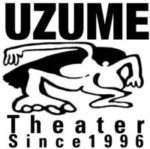→Japanese page
Written by Carlo Gozzi (Italy)
Period: April-May 2001
Venue: Mojiko Hotel Seaside Terrace, Mojiko-ku, Kitakyushu City
Author:Tomo Fujisawa
Date of writing; October 2016.
During Golden Week 2001, a wooden outdoor stage was set up at the terrace of the Mojiko Hotel, which is located at the heart of Mojiko Retro, a famous tourist attraction, and was staged for ten days. A total of 1,200 people attended the event, and since the event coincided with the Mojiko Retro Festa, the atmosphere around the outdoor terrace was filled with a lively and joyful atmosphere throughout the event. This was the result of the full cooperation and generosity of the Mojiko Hotel.
The play was written by Carlo Gozzi, one of the leading writers of the Italian classical comedy, Commedia dell’arte. In Japan, the Commedia dell’arte is the easiest to imagine if you put it in the context of Kyogen. The fact that it is a masked play and a comedy. The fact that the names of the characters are common symbols that refer to specific roles in several works. They have many elements in common, such as a satire of authority lurking in the midst of seemingly easy, popular laughter.
The masquerade completely shuts down facial expressions, which modern Japanese people, accustomed to TV and movies, tend to do. Actors have to manipulate their own body as a tool to clearly depict situations and relationships in a way that can be seen by distant viewers. It was an experience full of discoveries, even though I was perplexed and struggling with the expression of a body that is not usually used and that is unique to masks.
Looking back, two of the elements that have come to define Uzume Theater’s color since then seem to have started with “Oshika-Oh”. I believe that two of the elements of Uzume Theater’s color began with “Oshika-Oh”: to introduce little-known foreign plays to the domestic market and to create a different theatrical space without sticking to a particular style.
<The theater company that introduces foreign plays>
Prior to that, “The Star Prince” (Saint-Exupery), “Princess Media” (Euripides) and “Waiting for Godot” (Beckett) ,they were all foreign plays ,”Waiting for Godot” had been staged under different organizer. However, all of these plays are reasonably well known both inside and outside the Japanese theater world and have been performed by other theater companies. I remember that “Oshika-Oh” (originally titled “Il re Cervo”) was originally translated as “Oshika-Oh”, but the director and the members of the company discussed and changed the name of the play. At best, it was a start with a lot of freedom. In hindsight, maybe we should have just changed it to “The Deer King”! ,Ahead of Nahoko Uehashi!
When dealing with foreign plays, one thing that is usually mentioned is the problem of language. The teachers who translate and publish plays are not professional playwrights, but scholars of literature, so even when they read a play and say “I see”, it may not be appropriate for the actors to say it on stage. In addition, in the case of Uzume Theatre, Gessner is a European, so he inevitably needs to fix what he disapproves of, assuming that the rhythm, impressions, and situations and relationships depicted when the lines are actually uttered cannot be recreated.
This has nothing to do with “Oshika-Oh”, but I’ll give a concrete example for clarity.
For example,If I translate the original text correctly,
“Hei, what are you going back and forth so much here and there?”,
Is it necessary to change that to “What’s doing?” or “Where go on?” and or “Don’t wander off!”, We considered it one by one and one by one.
Goessner seemed to have awakened to this “discovery” during “Waiting for Godot”, but at any rate, this difficulty (or agony) continued to haunt the Uzume Theatre for a long time to come.
However, Goessner was difficult to read the Japanese lines. If he just read them to them, they would “understand the meaning, but not the situation”. So we had to have the actors actually perform in front of him to see if the situation was created as he knew it, if the rhythm was intact. We (and our guest) would try to play the lines as they were translated into Japanese, for now, and show him. And then he would ask, “Why does it take so long to get a line with just this many words in a row?” or “The scene we’re in now is about to create a situation of this and that, but is that what it looks like from a Japanese perspective? And then we do it. And if it didn’t work, we’d work on the lines.
It was all about whether the stage was showing what we wanted to show.
Continue to the second half
